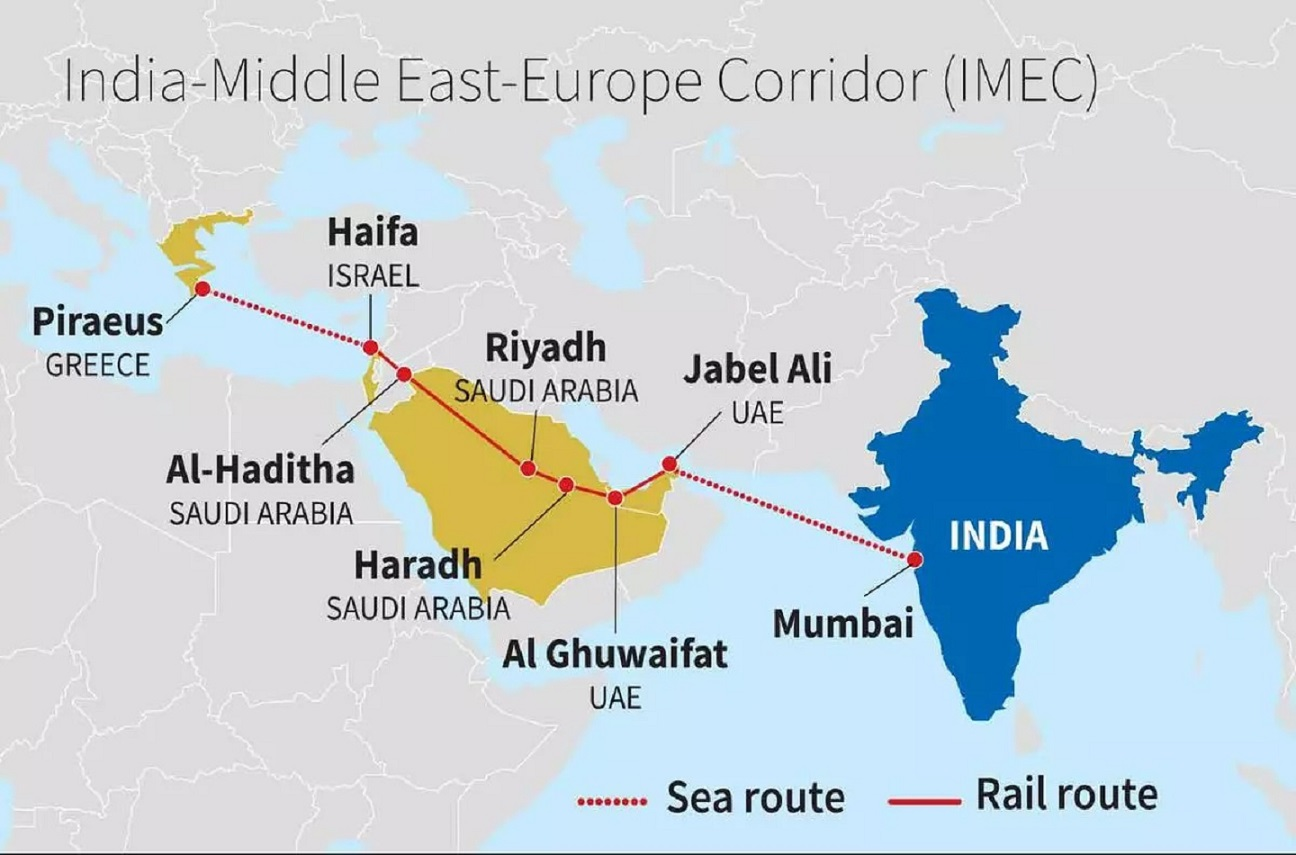Table of Contents
India-Middle East-Europe Economic Corridor (IMEC)
Context: Greek Prime Minister Kyriakos Mitsotakis stated that despite the Israeli conflict in Gaza impacting the India-Middle East Economic Corridor (IMEC) plans, India and Greece should continue their commitment to this “peace project”.
About IMEC

|
About IMEC |
|
| Signatories | India, United States, Saudi Arabia, United Arab Emirates, European Union, France, Germany, Italy. |
| Goals |
|
| Components |
|
| Part of | Partnership for Global Infrastructure Investment (PGII) |
Significance
Political Significance
- Counter to China’s BRI: IMEC offers an alternative to BRI’s “debt trap” and expansionist policies.
- Challenge China’s Middle East influence: Offers an alternative to China’s growing influence in the region.
- Promote Middle East stability: Aims to unite the region and avoid future conflicts.
- Normalise diplomatic relations: Could lead to improved relations between regional nations, including Israel and Saudi Arabia.
- Reduce dependence on Suez Canal: Provides an alternate trade route bypassing congested and potentially risky areas.
- Expand G20’s role: Strengthens G20 as a counterbalance to China and Russia’s dominant political forces.
Economic Significance
- Boost trade and jobs: Increases trade of goods, clean energy, and services, promoting economic growth and job creation.
- Infrastructure development: Addresses infrastructure gaps in lower- and middle-income nations.
- Green and digital connectivity: Includes infrastructure for electricity, hydrogen, and high-speed data, promoting sustainability and digital integration.
- Enhanced regional connectivity: Improves trade, prosperity, and overall connectivity within the region.
We’re now on WhatsApp. Click to Join
Cryogenic Engine
Context: ISRO’s CE-20 cryogenic engine for Gaganyaan’s LVM3 rockets passes human-rating tests.
About CE-20 Cryogenic Engine
- Developer: Liquid Propulsion Systems Centre (LPSC), part of the Indian Space Research Organisation (ISRO)
- Purpose: Powering the upper stage of the LVM3 launch vehicle
- Cycle: Utilises a gas-generator cycle, a first for Indian cryogenic engines.
- Propellants: Liquid hydrogen and liquid oxygen
Cryogenic Engine
- Complexity: Technically challenging due to propellants stored at extremely low temperatures (-183°C for LOX, -253°C for LH2).
- Efficiency: Despite complexity, very efficient, providing more thrust per kilogram of fuel than traditional options.
- Propellants: Typically uses liquid oxygen (LOX) and liquid hydrogen (LH2).
- Function: LH2 acts as fuel, reacting with LOX (oxidizer) to create thrust.
- Operation: Continuous booster pumps push these liquids into the combustion chamber for ignition.
|
About Gaganyaan Mission |
|
| About | The Gaganyaan mission is India’s first human spaceflight mission. It is scheduled to launch in 2025 and will carry three Indian astronauts to Low Earth Orbit (LEO) for a period of five to seven days. |
| Objectives |
|
| Aim | To launch a human crew into a 400 km orbit and return them safely to land in Indian sea waters as a demonstration of human spaceflight capability. |
| Launch Vehicle | GSLV Mk III, also called the LVM-3 (Launch Vehicle Mark-3) |
| Payloads | Consist of:
|
India’s Smartphone Exports
Context: India’s smartphone exports have increased from 1% to 2.5% in the last decade.
Key Data And Points
- Target: India aims to export 600 million mobile phones worth $110 billion by 2025, as per the National Policy on Electronics 2019.
- Current Reality: Exports hovering below $10 billion, falling short of target.
- Domestic Consumption: Significant portion of Indian-made smartphones are consumed domestically.
- High Import Tariffs: India charges 20% tax on chargers and circuit boards, potentially hindering competitiveness.
- Vietnam’s Growth: Before 2010, both India and Vietnam had less than 1% export share.
- By 2022, Vietnam’s export share rose to 12%, while India’s was a little over 2.5%, ranking seventh.
- US Market: Vietnam doubled its share in US smartphone imports (18% in 2022) while India’s share is negligible.
- UAE & Germany: India’s share in smartphone imports is growing in these markets, while Vietnam’s is declining.
- Regional Export Leaders in India: Kancheepuram (Tamil Nadu), leads in smartphone exports, contributing to nearly 38% of India’s total mobile exports.
- Other significant regions include Gautam Buddha Nagar in Uttar Pradesh and Kolar in Karnataka.
Fair and Remunerative Price (FRP)
Context: The Cabinet Committee on Economic Affairs (CCEA) chaired by Prime Minister Narendra Modi approved the Fair and Remunerative Price (FRP) of sugarcane for Sugar Season 2024-25 at ₹ 340/quintal at a sugar recovery rate of 10.25%.
About Fair and Remunerative Price (FRP)
What is it?
- Minimum price sugar mills must pay farmers for sugarcane.
- Ensures farmers receive a fair return, regardless of sugar mill profits.
- Applies uniformly across India.
Who determines it?
- Union government: Cabinet Committee on Economic Affairs (CCEA)
- Based on recommendations from the Commission for Agricultural Costs and Prices (CACP)
How is it calculated?
- Considers various factors:
- Cost of production for farmers
- Demand and supply of sugarcane
- Domestic and international sugar prices
- Comparison with prices of other crops
Benefits:
- Guaranteed minimum income for sugarcane farmers
- Encourages stable sugarcane production
- Promotes fair trade practices in the sugar industry
Related information:
- Some states offer additional State Advised Prices (SAP) on top of FRP.
- FRP is determined under the Sugarcane (Control) Order, 1966.
INDUS X
Context: The second edition of INDUS X Summit was conducted in New Delhi.
About INDUS X
Basic Information
- Full form: India – U.S. Defense Acceleration Ecosystem (INDUS-X)
- Inception: Launched in June 2023
- Objective: INDUS-X aims to enhance the strategic technology partnership and defence industrial collaboration involving the governments, business sectors, and academic institutions of India and the United States.
- Guiding Bodies: The initiative is spearheaded by India’s Innovations for Defense Excellence (iDEX) and Ministry of Defence, and US Department of Defence (DoD) in the U.S.
Key Activities
- Initiatives: INDUS-X encompasses various activities including joint prize challenges for startups, roundtable discussions, mentor-protege programs linking major companies and startups, and the establishment of a Senior Advisory Group, among others.
Strategic Importance
- This initiative is a progression of the commitment made by theS. and Indian National Security Advisors in January 2023.
- Connection to iCET: They pledged to initiate an “Innovation Bridge” that would link U.S. and Indian defence startups, as a part of the U.S.-India initiative on Critical and Emerging Technology
| Overview of iDEX Framework |
Objectives
Defence Innovation Organization (DIO)
|


 List of Military Exercises of India 2024...
List of Military Exercises of India 2024...
 India to Host First Global Conference on...
India to Host First Global Conference on...
 How Terror Networks Abuse Digital Tools
How Terror Networks Abuse Digital Tools





















